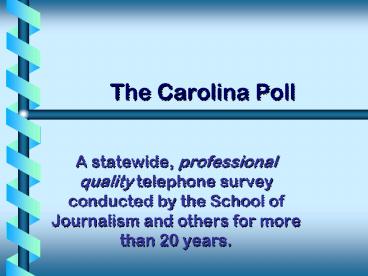The Carolina Poll
1 / 18
Title: The Carolina Poll
1
The Carolina Poll
- A statewide, professional quality telephone
survey conducted by the School of Journalism and
others for more than 20 years.
2
What polls can measure
- Narrow behavior choices (like voting)
- Thoughtless opinion
- Salient issues (support/oppose)
- Simple evaluations (good/bad)
- Recent, specific behavior
- Reasons for behavior (sometimes)
3
What you can do with polls
- Estimate population parameters.
- Locate and describe certain kinds of individuals.
- Explain individual or social behavior.
- Test hypotheses about how social system operates.
- Measure influence of the media.
4
Principles of polls
- A relatively small, carefully drawn sample can
come close to a very large population. - The error associated with the sample estimate can
be measured.
5
Logic of sampling
- We draw random samples of large populations and
measure interesting characteristics or
statistics. - We use the sample statistics to estimate
parameters of the large population. - We can calculate the probability of error
associated with our estimates.
6
The famous sampling error
1.96
p q
n
Where p percent q 100 p n sample size
7
Probability applied
- A random survey of 600 found that 40 support
Issue A. - Our best guess of the entire population is that
40 support Issue A. But probably not. - We are 95 certain that 36-44 of the population
support Issue A. - How do we come up with that?
8
Calculations
- p 40 q (100-p) or 6 n600.
- p q 40 60 2400
- 2400/600 4
- v4 2
- 1.962 4
- Population estimate equals sample figure 4.
9
Really important ideas
- Accuracy of sample has nothing to do with size of
population from which it is drawn. - Accuracy does depend on
- Size of sample and variance within in.
- Biases or non-random exclusion of elements of
the population.
10
Most important ideas
- Key to good surveys is getting a good sample, not
a big one. - And asking questions that people can and are
willing to answer.
11
Questions you should not ask
- What is the sampling error? (You know how to
calculate it) - Was it a good sample? (Is it good enough for your
purposes?)
12
Questions you should ask
- Does the sample match, more or less, the
population? - Do weaknesses of the sample affect the
conclusions you want to draw? - Can people realistically answer the questions?
Are they willing to?
13
Good poll stories
- Present results. Get reaction.
- Explain opinion describe or locate subgroups.
- Test argument or hypothesis.
- Confront assertions.
14
A typical story
- Almost half (45) of North Carolina residents
believe the country is heading in the wrong
direction, a sharp increase from one in five
(20) in the spring, according to the UNC-CH
School of Journalism and Mass Communication. - Reaction or details
- Technical stuff
15
The technical stuff
- The figure is based on telephone interviews with
a representative sample of 512 adults in the
state in early November. In 95 out of 100
surveys of this size, results are within 4 of
the figures obtained by interviewing all adults
in the state.
16
Other good story ideas
- Show change over time by comparing results with
previous surveys. - Compare results with state-wide or national
surveys. - Who supports/opposes policies. Is it race or
gender issue? Partisan issue?
17
For help with analysis
- See Joseph Kim in the School of Journalism
Research Center (Room 340)
18
Other resources
- Odum Institute on campus (www2.irss.unc.edu)
- Pew Center for People and the Press
(www.people-press.org) - Univ Maryland website for analysis of General
Social Survey (www.webuse.umd.edu)































